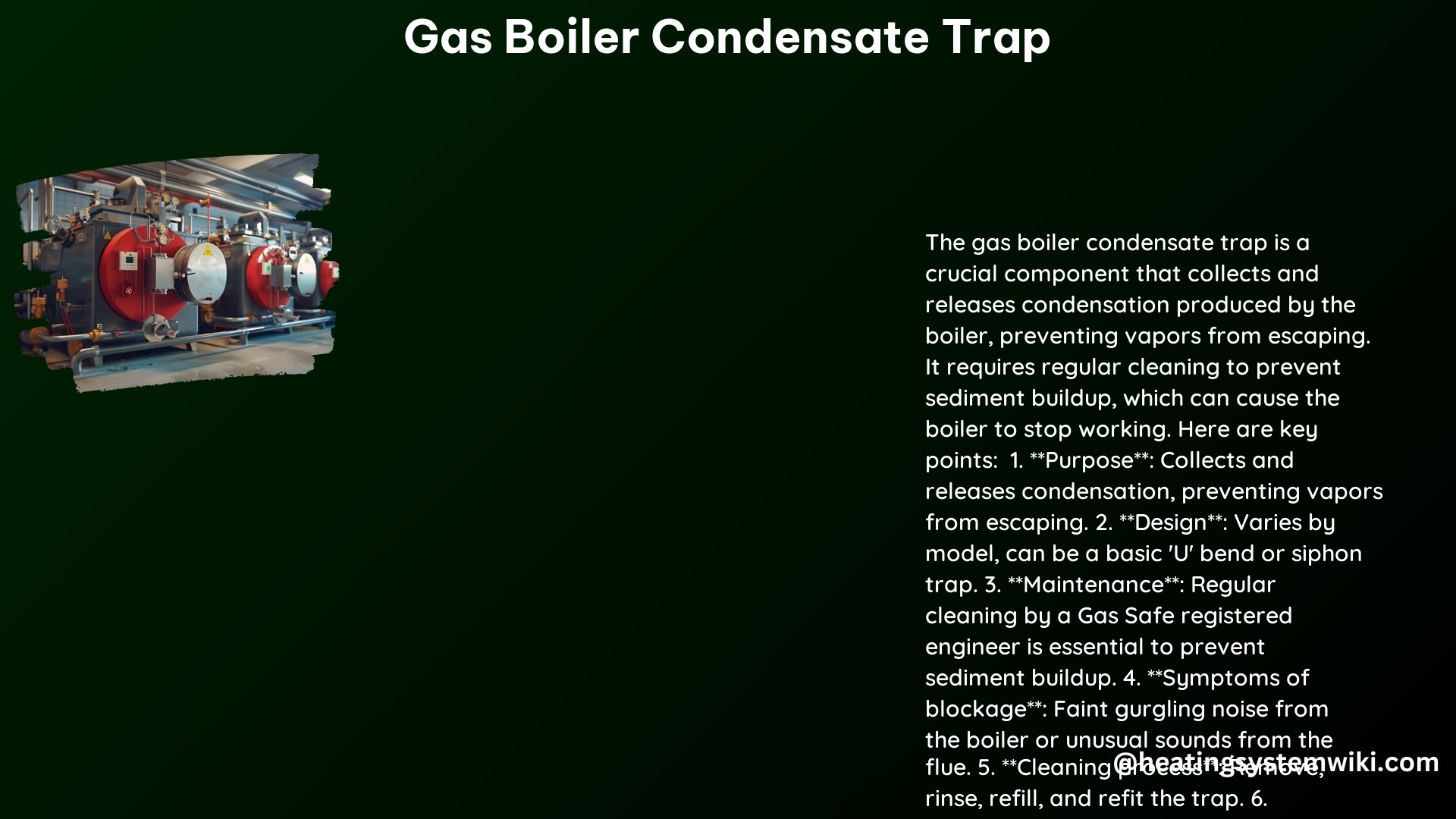The gas boiler condensate trap is a crucial component in condensing gas boilers, designed to safely collect and release the condensation produced during the combustion process. This comprehensive guide will delve into the technical specifications, function, cleaning, maintenance, and disposal of the gas boiler condensate trap, providing you with a detailed understanding of this essential piece of equipment.
Technical Specifications
Manufacturer and Part Number
The gas boiler condensate trap is manufactured by NTI Boilers (NY Thermal Inc.) and has a part number of 82913. This specific model is designed to work with a wide range of NTI’s condensing gas boilers, ensuring compatibility and optimal performance.
UNSPSC Code
The UNSPSC (United Nations Standard Products and Services Code) for the gas boiler condensate trap is 40101851. This code is used to classify and identify the product for procurement, logistics, and data analysis purposes.
Dimensions and Capacity
The NTI 82913 condensate trap measures 4.5 inches (114 mm) in height and has a diameter of 2.5 inches (63 mm). It has a maximum condensate flow capacity of 2.6 gallons per minute (9.8 liters per minute), ensuring it can handle the typical condensate production of a residential or light commercial condensing gas boiler.
Material Composition
The condensate trap is constructed from high-quality polypropylene, a durable and corrosion-resistant material that can withstand the acidic nature of the boiler condensate. This material selection ensures the trap’s longevity and reliable performance over time.
Function and Purpose

Preventing Air Flow
The primary function of the condensate trap is to prevent air from entering or leaving the boiler equipment while allowing the condensate to drain away. This is achieved by creating a column of condensate that acts as a water seal, effectively blocking air flow and maintaining the necessary pressure differential within the boiler system.
Freezing Prevention
The condensate trap plays a crucial role in preventing the freezing of the condensate line. By ensuring that the water drains without air flowing into the drain line, the trap eliminates the risk of water backing up and freezing, which could lead to blockages and potential system failures.
Condensate Neutralization
Some gas boiler condensate traps are equipped with a built-in neutralization cartridge or chamber. This feature helps to neutralize the acidic nature of the condensate, reducing its corrosive effects on the drainage system and the environment before it is discharged.
Cleaning and Maintenance
Regular Servicing
Regular servicing by a Gas Safe registered engineer is essential to maintain the proper function of the gas boiler condensate trap. During these service visits, the engineer will inspect the trap for any signs of sediment buildup or blockages and clean it as necessary to ensure optimal performance.
Recommended Cleaning Frequency
It is generally recommended to clean the condensate trap at least once a year, or more frequently if the boiler is operating in a high-dust or high-debris environment. This proactive maintenance helps to prevent issues such as boiler shutdowns or unusual noises that can indicate a blocked trap.
Cleaning Procedure
To clean the condensate trap, the engineer will typically follow these steps:
1. Disconnect the trap from the condensate drain line.
2. Disassemble the trap and remove any accumulated sediment or debris.
3. Rinse the trap components with clean water to ensure they are free of contaminants.
4. Reassemble the trap and reconnect it to the condensate drain line.
5. Verify the proper operation of the trap by checking for any leaks or obstructions.
Disposal of Condensate
Gravity-based Systems
One method for disposing of boiler condensate is through a gravity-based system. In this approach, the condensate is drained directly into a suitable drainage point, such as a floor drain, sewer, or soakaway, using a downward-sloping pipe. This method relies on the natural flow of the condensate and requires careful installation to ensure proper drainage.
Pump-based Systems
For situations where a gravity-based system is not feasible, a pump-based system can be used to dispose of the boiler condensate. This method utilizes a condensate pump to actively transfer the condensate to a suitable drainage point, often located at a higher elevation than the boiler. Pump-based systems require additional components, such as a condensate pump and associated piping, and must be installed according to manufacturer specifications.
Pipe Material Selection
Regardless of the disposal method, it is essential to use non-corrosive pipes and fittings to transport the boiler condensate. The acidic nature of the condensate can cause damage to certain materials, such as copper or galvanized steel. Instead, it is recommended to use pipes made of materials like PVC, CPVC, or polypropylene to ensure the long-term integrity of the drainage system.
Additional Considerations
Pitch of Drain Pipe
The drain pipe connected to the condensate trap should always pitch downward to ensure proper drainage. If this is not possible, the pipe should run horizontally below the trap outlet to maintain a consistent downward slope and prevent water from backing up.
Termination Point
The termination point of the condensate drain line is an important consideration. The condensate should be discharged in a way that does not cause damage to the property or the environment. Factors to consider include the pH level of the condensate, local regulations, and the potential impact on the sewage system or nearby waterways.
Condensate Neutralization
In some cases, the acidic nature of the boiler condensate may require additional neutralization before it can be safely discharged. This can be achieved by installing a condensate neutralization system, which typically includes a cartridge or chamber filled with a neutralizing agent, such as calcium carbonate or sodium hydroxide.
References
- Design Air. (n.d.). Gas Boiler Condensate Trap. Retrieved from https://www.designair.com/index.jsp?path=product&title=gas.boiler.condensate.trap&part=DA103211
- Pace Supply. (n.d.). Condensate Trap. Retrieved from https://pacesupply.com/Product/nti82913
- HVAC-Talk. (2012, August 11). Why the condensate drain trap? Retrieved from https://hvac-talk.com/vbb/threads/282442-Why-the-condensate-drain-trap
- Viessmann UK. (n.d.). How to Clean a Boiler Condensate Trap. Retrieved from https://www.viessmann.co.uk/en/heating-advice/boilers/how-to-clean-boiler-condensate-trap.html
- U.S. Boiler Company. (2018, October 10). The Proper Disposal of Boiler Condensate. Retrieved from https://www.usboiler.net/proper-disposal-boiler-condensate-html.html
